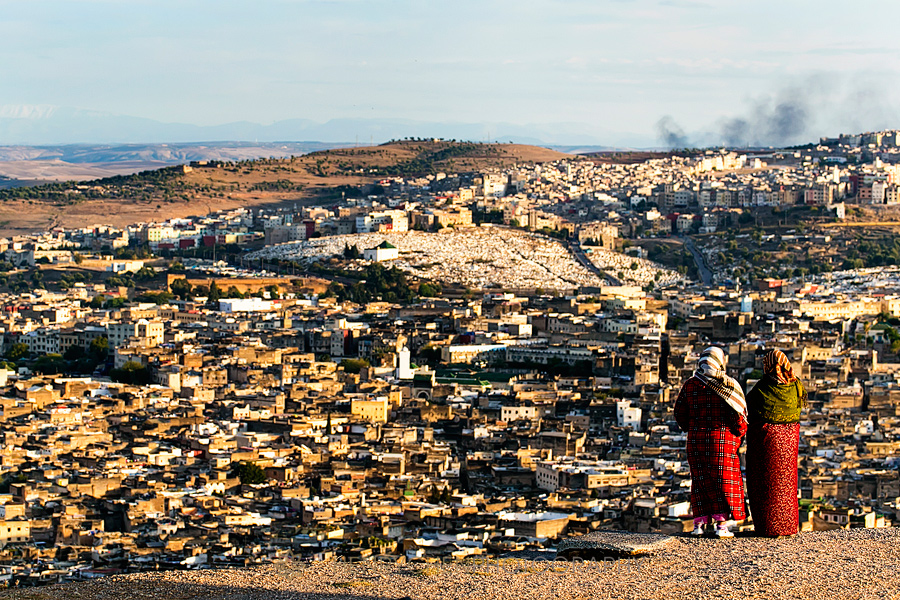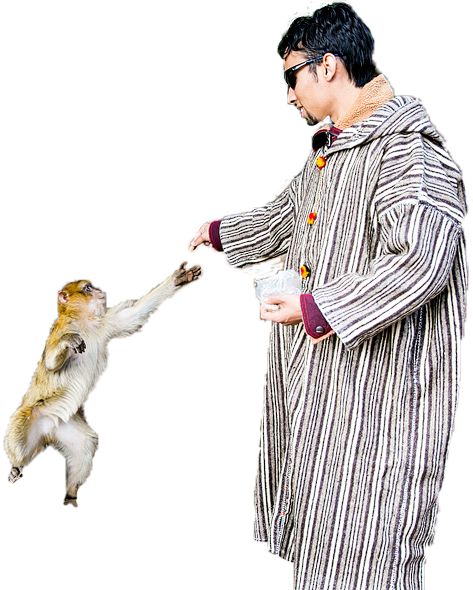Moroccan Landscape
Like a Berber carpet, the varied countryside enjoys stark contrast from deep, lush, valleys to crashing oceans. From the Gorges to Sahara desert all the way to the magical peaks of the High Atlas and Riff Mountains.
Morocco is a breathtaking oasis and a dream destination for many travelers.
Moroccan Life and People
Morocco is a tree with roots in Africa and branches in Europe, which is to say, there is a large variety in the Moroccan way of life.
In many places there is the hustle and bustle of modern life but in the rural areas it grinds to a halt and we find people working in the fields and doing the same work that’s been done for decades.
No matter the place, Moroccans remain closely connected to the environment, and with each other.
Cafes are a meeting point for Moroccans where they take time to discuss their daily life. You can find most of the cafes full of men waiting for their mint tea, the trick is to leave enough time to watch the world go by with the locals.
Of course, that can be tricky since there are so many activities to do starting with the cuisine: learning how to make a tagine, rolling, swelling, and steaming the couscous to camel trekking, shopping in the souks, and let’s not forget getting lost in the medina which can be one of the best experiences you might have. One unforgettable experience you must enjoy in Morocco is sleeping in a traditional riad.
Moroccan families values are given a lot of importance in Morocco, The elders in each Moroccan family are respected and strongly influence the rest of the members of the family.
When greeting in Morocco it is very common traditionally to kiss each other on the cheeks for the same gender.
Also, should you have the chance to visit someone’s home, it is customary to take dates, flowers, or some fruit when someone opens their doors to you, Moroccan families love to share with their guests and this small gesture goes a long way!
Most women in Moroccan society are housewives, so you’ll rarely find a woman working in the factories, companies or any industrial, business buildings, however; nowadays women play a big role supporting men side by side and making the Moroccan community a strong and unique differ from any society and that happens in the modern big cities, in the rural areas women are still working at home and in the fields.
Principles of sound democracy are heralded in Morocco and are already on their way to modernize the country. The new family code adopted by the parliament in 2003 has granted equal status to women in marriage, children and property.
Fighting against religious fanaticism and striving to modernize Islam, Morocco is emerging as a model for democratic Islam. Ethnically and culturally, one can say that today’s Morocco is the least Arabic among Arab countries.
The Medinas

Ancient fortified cities are often exotic and found in most of the imperial cities, the Medina is an outstanding and well preserved ancient capital of Morocco.
Unesco has bestowed world heritage status on several medinas including Fes –the Wolrd’s largest Medieval Islamic city.
We can’t forget about and the carnivalesque Djemaa el Fna in Marrakech, or the world’s Largest Kasbah found right here in Morocco: Ksar Ait Ben Haddou, the home of Berber traders.
The Ksar; a group of earthen buildings surrounded by high walls, is a traditional pre-saharan habitat. The Houses crowd together within the defensive walls, which are reinforced by corner towers and promise to hold steady under attack.
Ksar of Ait Ben-haddou is a striking example of the architecture of southern Morocco.
If you’re wondering the difference between a Ksar and a Kasbah, here it is a Kasbah Means a fortified Town that is pierced by the towers in the corners for protection and it’s under control of only one family.
Culture
Morocco also considered by some a berber-arab country, while others back the african-berber identity, as the majority of people practice Islam. Morocco is an open-minded and modern yet traditional country and enjoys religious diversity as Christianity and Judaism are also practiced within the country, though mainly in Casablanca.
Morocco has been greatly influenced by the traditions and passage of time, that’s reflected in their traditional dress and way of living. Even though modern life is making it’s way into Morocco there are still parts of tradition deeply woven into the fabric of the country, and arranged marriages even exist in many parts of the kingdom.
Berber Social Structure
It is typically the men who choose a wife for themselves within their tribe, but in some tribes the decision is taken from him and is made by the families. Although in the Tuareg tribe it is the woman who chooses the man she would like to marry. It will depend on the tribe whether the family structure is patriarchal or matriarchal. The strict adherence to custom has given the Berber people a strong sense of unity and has protected their culture.
Religion
A large Jewish Berber population could be found in Morocco up until the 1960’s, now much smaller after their numbers decreased dramatically as a result of emigration.
Many Christian Berbers have also emigrated, mostly to France, with only a handful remaining in Morocco.

The Language
Most all Moroccans speak both “Darija” a type of mixed Moroccan Dialect and french mostly, so Darija is most spoken in most parts of the counrty, meanwhile; we found the berbers in the mountains and deserts speaks only Tamazight which is a spoken language and has recently become a written language that’s taught in schools. The berber scripts are called Tifinagh and you will see their symbols starting to appear all over the country, though more often in villages.
Tamazight is the modern tongue of berbers, which is varied and is divided into three parts of Morocco: we find ” Tarifiyte” in the north parts of the country, “Tachlhait” in the Atlas mountains and south east, and “Sousia” in the west of Morocco at the Sous regions.
A modernized form of the Tifinagh alphabet was made official in Morocco in 2003. Algerians mostly use the Berber Latin alphabet. Mali and Niger recognize a Tuareg Berber Latin alphabet customized to the Tuareg phonological system. However, traditional Tifinagh is still used in those countries. Both Tifinagh and Berber-Latin alphabets are being increasingly used in Morocco.
French is more spoken in the big cities of Casablanca, Rabat and the regions, as it’s the second official language in Morocco that is taught in schools and used for many official government business and elite circles.
The Festival of Fantasia
The performance is an exhilarating colorful display of expert riding. A group of riders adorned in traditional dress, line up on their horses. They rush forward at great speed for about 200 meters before firing their old gunpowder loaded weapons, into the air, in unison, effectively creating one synchronized sound. This is where the skill lies. The riders have to not only keep their horses in a straight line while charging forward but have to also fire a single shot at the very same moment as their fellow riders.
The horses are known as Fantasia horses and the performance is a testament to the bond between man and his horse.
The Game of Gunpowder is inspired by the wartime strategy used by the Berber warriors as they charged their enemies in the desert. Today it is considered a form of martial and cultural art. There are some restaurants in Morocco that offer Fantasia riders as part of the dinner entertainment.
Berber Art and Culture
This allows the women to continually collect different plants that they will use to dye wool and cotton. Their livestock provide them with wool which they use to weave kilims, a tapestry like woven carpet. These are sometimes made for personal use but are also often sold at local souks (markets). The patterns woven into the kilims are distinctive and characteristic of the tribe and region. The Moroccan Berber women like to embellish their kilims with fringes and sequins whereas other Berber weavers from different regions will simply use geometric designs such as diamonds and triangles.
Berber art is predominantly crafted and expressed as wearable or useable pieces such as in pottery, furniture, fabrics, jewelry or carpets. Artistic design is also represented in their architecture.
Berber Cuisine
WHY Morocco Expert Tours?
Rest assured that Morocco Expert Tours is a courteous and personable yet professional company ran by two brothers, our small but well-trained staff means you’re going to get a tailored experience to suit your exact needs whether it’s your honeymoon, a trip with friends or family or even a solo holiday.
We are proud to share with you our culture and will ensure you get a unique taste of Morocco while learning about history, architecture, archeology, and of course, the delicious food.
You’ll experience firsthand the warmth of the “Amazigh” culture and here you will create your own story of Morocco.
We’re waiting to help you experience the brilliant souks and navigate the winding walled medinas, point you towards the best places to live the local life, experience varied climates and geography, and above all, to have a once in a lifetime experience. When you join Morocco Expert Tours, you join our Berber family, and together, we will travel our country.
Morocco Expert Tours, has an excellent reputation that we are very proud of, and have worked hard for. Our team is flexible, knowledgeable, highly skilled and ready to create your perfect trip so you can enjoy a dream holiday. to acheive your dream Holiday.
Feel free to reach out and talk to us, we’re happy to answer any questions or doubts you may have or help you in any way. Of course we understand that research is key when it comes to planning a trip to a country like Morocco, so we encourage you to check us out on TripAdvisor, look at our testimonials here on the site, as well as enjoy some of the blog posts we’ve had written about us.
Thank you so much for visiting our site, we cannot wait to welcome you to beautiful, magical Morocco — we’ll be here waiting for you.

